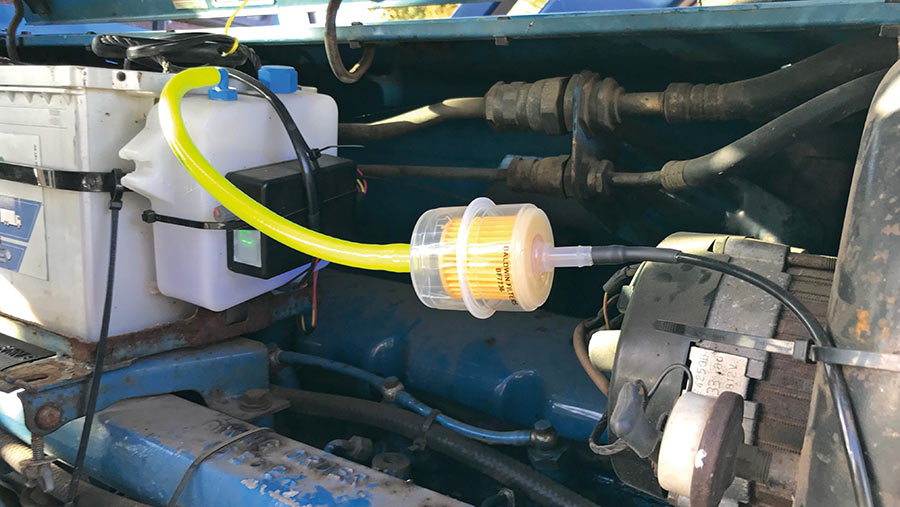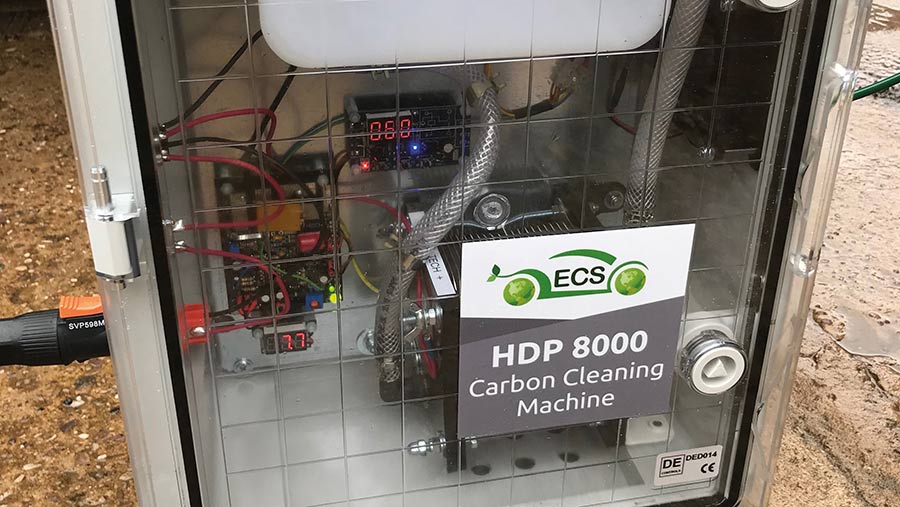Hydrogen-based cleaning kits get old engines running smoothly
 © Oliver Mark
© Oliver Mark A system for clearing carbon deposits from coked-up engines is now being offered by a Warwickshire firm as an on-farm service.
Hydrogen cleaning has been used in the automotive industry for more than 20 years as a means of improving the efficiency and smooth running of engines affected by a build-up of carbon deposits.
With the launch of their Hydrogen Culture business, farmer’s son Tim Wade and former Same Deutz-Fahr engineering trainer Rob Hawker hope to bring the service to agriculture.
See also: Aberdeenshire farmer’s retrofit hydrolyser cuts diesel use by 20%
“Having had experience of using hydrogen carbon cleaning on our own cars and vehicles, we knew the benefits it could bring, particularly to engines suffering coking,” says Mr Wade.
“Coming from farming and engineering backgrounds, we quickly identified the potential of the system for improving the performance of machines that might be suffering carbon deposit build-ups.

Tim Wade and Rob Hawker © Nick Fone
“It’s things like telehandlers and scraper tractors which rarely get worked really hard that tend to suffer issues from coking up.
The fix of just giving them a good blow-out every now and then can put unnecessary stress on the engine and that sort of short, sharp shock is rarely sufficient to clear carbon deposits properly.
“Really, there’s no substitute for a deep clean. Without pulling the engine to pieces the best way to do this is to use hydrogen treatment.”
The options
The business offers two different options for machine owners who suspect carbon deposits may be suppressing the performance of an engine.
The first is an intense deep-clean treatment that involves a standalone hydrogen generator plumbed into the vehicle’s air-intake.
Set up to run for up to an hour with the engine ticking over, it is said to break up and remove the worst coke deposits which can affect injector nozzles and intake air swirl patterns. It can even shift carbon around the valve train and piston rings that can reduce compression.
Alternatively, a small on-engine unit can be permanently installed to deliver a low dose of hydrogen whenever the engine is running to gently clean and maintain its inner workings.

Providing a constant trickle of oxyhydrogen gas to keep things clean, the on-engine unit doses a small quantity into the engine air intake © Nick Fone
A cathode-anode arrangement in a small on-board tank filled with an electrolyte solution uses a 12V electrical feed to produce small quantities of oxyhydrogen (HHO), a combustible mixture of oxygen and hydrogen, which is fed into the intake manifold.
The operator can adjust the amperage going through the unit to vary the amount of gas produced.
“Many people in the automotive world will talk about improved engine performance and reduced fuel usage and we’ve certainly seen that on our own vehicles,” says Mr Hawker.
Fuel savings
“We’re fairly conservative in making claims about fuel savings but would certainly hope to see a 5% reduction in most engines.
“But we’ve gone one step further in measuring emissions with the treatment kit installed.
Using an exhaust gas analyser we’ve seen a reduction in the output of carbon dioxide, hydrocarbons and nitrogen oxides – all indicators of a more efficient running engine.
“Much of this is frequently down to restricted airflow. You’ll often see black smoke from a coked-up engine.
“That’s unburnt fuel coming out of the exhaust because the fuel-to-air ratio is being affected by a gummed-up intake.
“Modern variable geometry turbos are particularly prone to seized vanes as a result of carbon build-up. Hydrogen cleaning does away with this.”
Any form of internal combustion engine can be treated – petrol or diesel, from chainsaws to foragers.
Cost
Generally, a one-off deep clean will cost about £100, with a fuel additive and cabin sanitiser treatment included in the package.
The self-fit on-engine kits vary in price depending on engine size, but for 4- to 8-litre blocks, prices are about £300-£400.
Hydrogen hygiene

As a one-off treatment, current is passed through a tank of electrolyte in the ECS carbon cleaning machine to produce oxyhydrogen gas which is then fed into the engine air-intake to break up carbon deposits © Nick Fone
What is hydrogen engine cleaning?
The concept is fairly simple – oxyhydrogen gas (HHO) is pumped into the engine air intake, helping to break up any carbon deposits that could be detrimental to the smooth and efficient running of the motor.
According to proponents of the system, this “de-coking” can help to improve fuel economy and do away with issues such as sticky EGR valves, faulty swirl flaps and even under-performing turbos.
What is oxyhydrogen?
Oxyhydrogen is a mixture of oxygen and hydrogen gases.
Being formed from water, the proportion of molecules mirrors that of the most abundant substance on the surface of the Earth, hence HHO.
In the world of engineering it’s also known as Brown’s gas.
Named after Yull Brown, a Bulgarian-Australian inventor who developed a way of producing this highly volatile gas in the 1970s, it was initially used as a fuel and was widely adopted for use as a welding gas.
The energy used to produce it through electrolysis is significantly greater than its calorific value, so its use as a fuel didn’t go far.
However, pumped into an engine in small quantities as either a one-off treatment or at a constant low level, it is claimed to have significant positive benefits.
How does hydrogen engine cleaning work?
HHO is produced by passing a strong electric current through water, splitting the molecules into their component atoms.
These highly charged particles of hydrogen and oxygen are passed into the intake manifold and burnt as the engine runs.
As it passes through the induction system, combustion chamber and exhaust, the hydrogen is said to react with any carbon deposits, lifting them from the various engine components.
The resulting gas exits the engine via the exhaust system.

